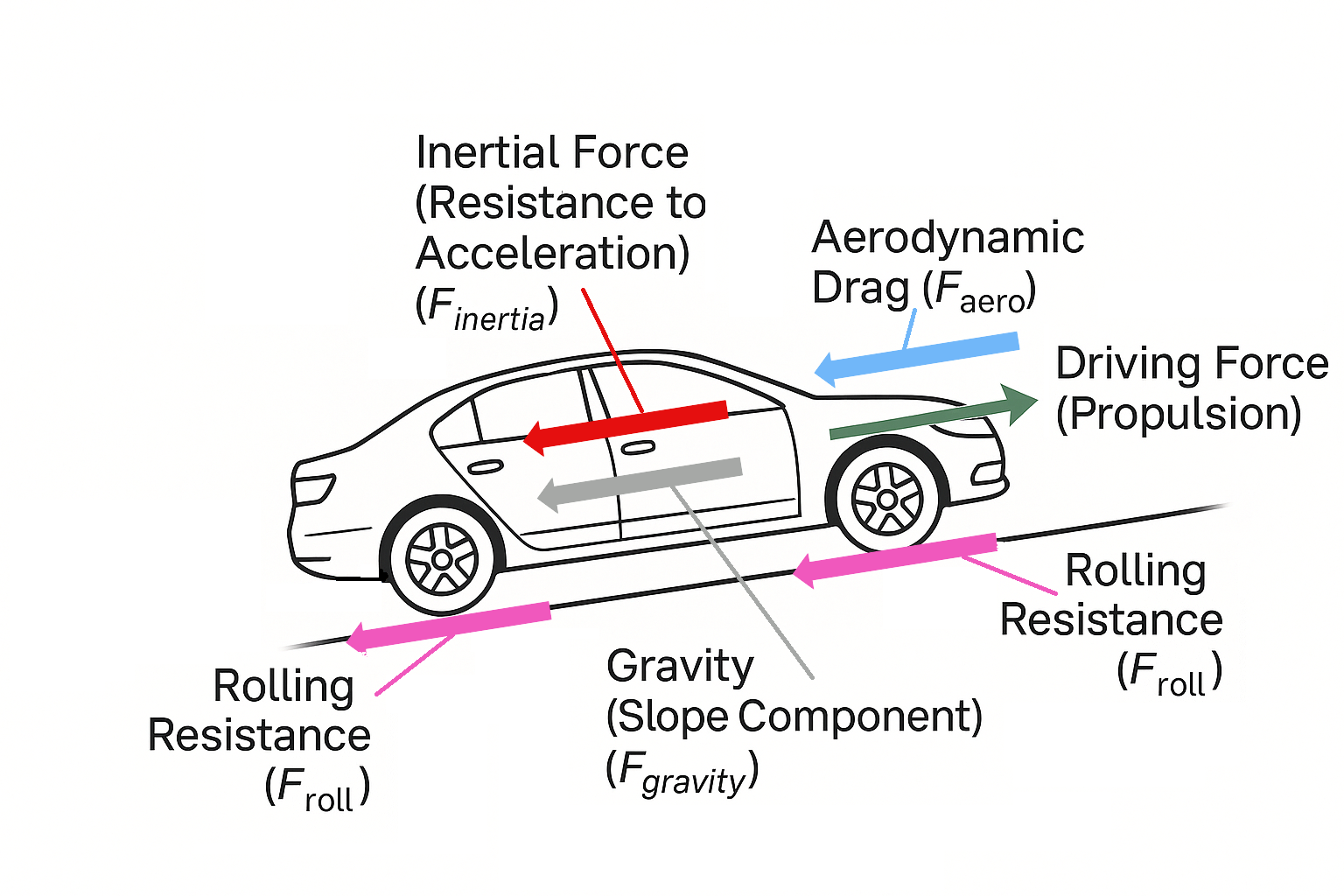Curious about electric vehicle running costs? Stop guessing the fuel charge for each trip or how much electricity an EV *really* uses in comparison to a gasoline or diesel vehicle. Our free web app provides detailed, real-time energy monitoring tailored for both electric (EV) and conventional fossil fuel vehicles. Use it in your journeys, learn consumption patterns, compare costs per mile or kilometer based on your local prices, and discover powerful energy savings opportunities to lower your energy bill.
Mobile App: Our app is also available as "Watts App" on Android platform Download Watts App from Google Play Store
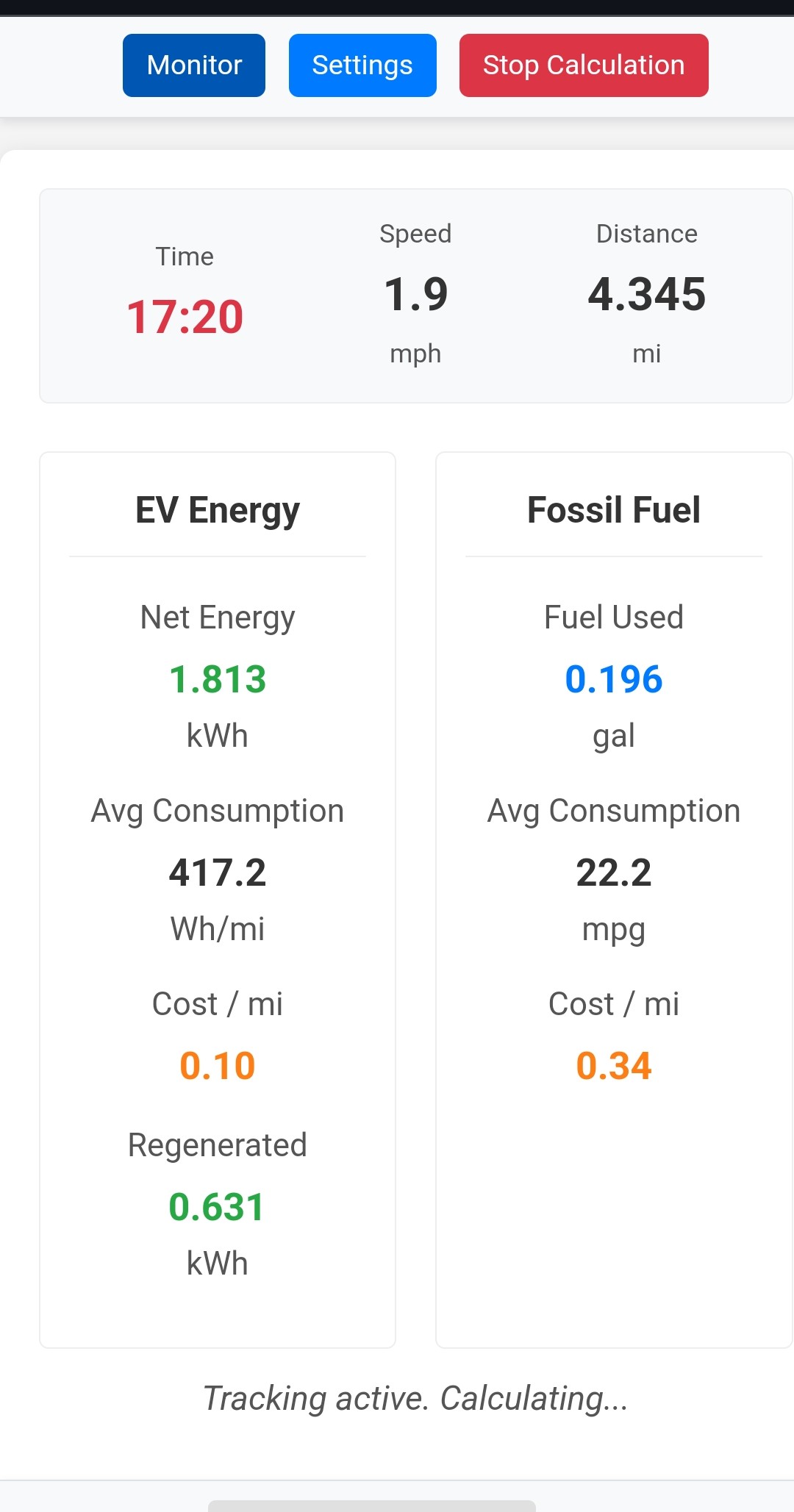
Key Feature: Track and Compare Electric Charge with Fuel Energy Consumption
EV Energy Monitoring
- Calculate Net Energy Used (kWh) considering propulsion and regeneration.
- Track Regenerated Energy (kWh) captured during braking/deceleration.
- View Average Consumption (Wh/km or Wh/mi) for trip analysis.
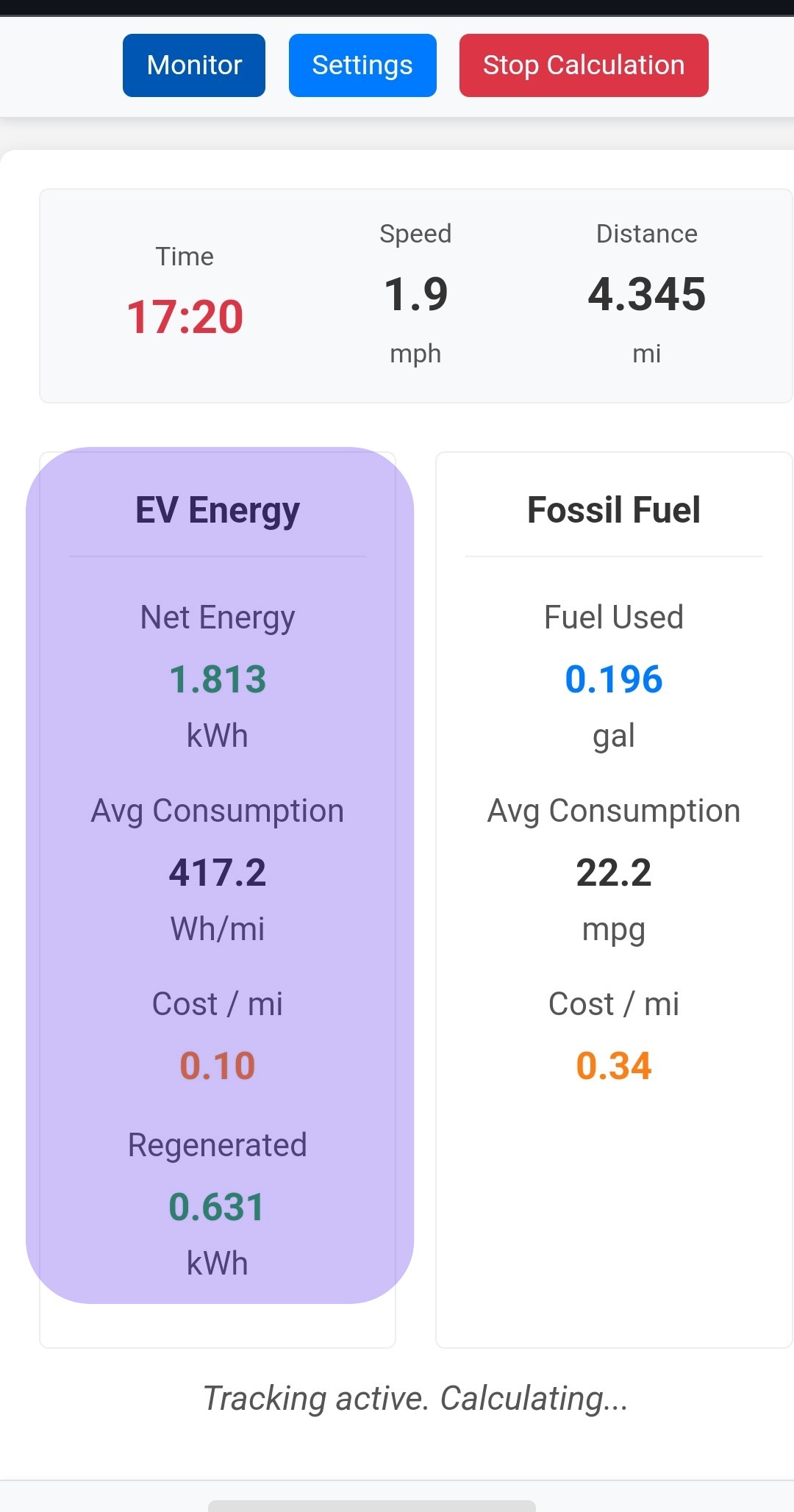
Fossil Fuel Consumption (Petrol/Diesel)
- Supports both Petrol and Diesel fuel types.
- Estimates total fuel consumed (Liters or Gallons) based on energy needs and engine efficiency.
- Calculates Average Fuel Consumption (L/100km or MPG). Helps understand the actual charge for gas per distance.
Trip Cost Calculation
- Determine your precise cost per kilometer or cost per mile.
- Input your local electricity price (€/$/£ per kWh).
- Input your local fuel price (€/$/£ per Liter/Gallon).
- Directly compare the running costs for different trips or driving styles and start saving!
Real-Time GPS Monitoring
- See your current speed (km/h or mph) live.
- Track the total distance traveled (km or mi) for your trip.
- Monitor elapsed trip time with the integrated MM:SS timer (active during calculation).
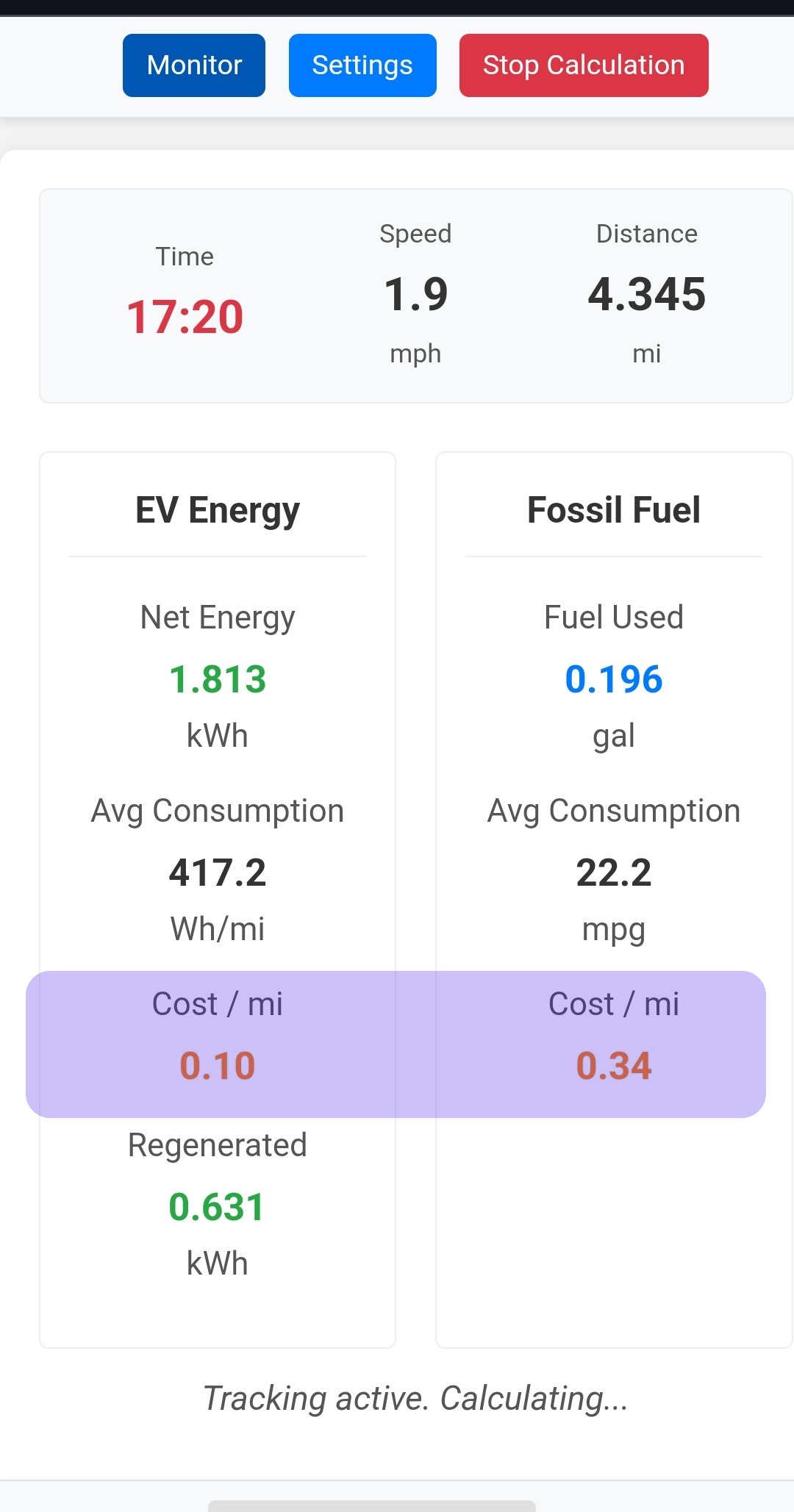
Customization & Flexibility
- Fine-tune calculations with vehicle parameters: Mass, Aerodynamic Drag (CdA), Rolling Resistance (Crr).
- Adjust Drivetrain Efficiency, EV Regenerative Braking Efficiency, and ICE Engine Efficiency percentages.
- Instantly switch between Metric (km, L, kg) and Imperial (mi, gal, lbs) units for all inputs and displays.
- Optional "Keep Screen Awake" feature for uninterrupted monitoring.
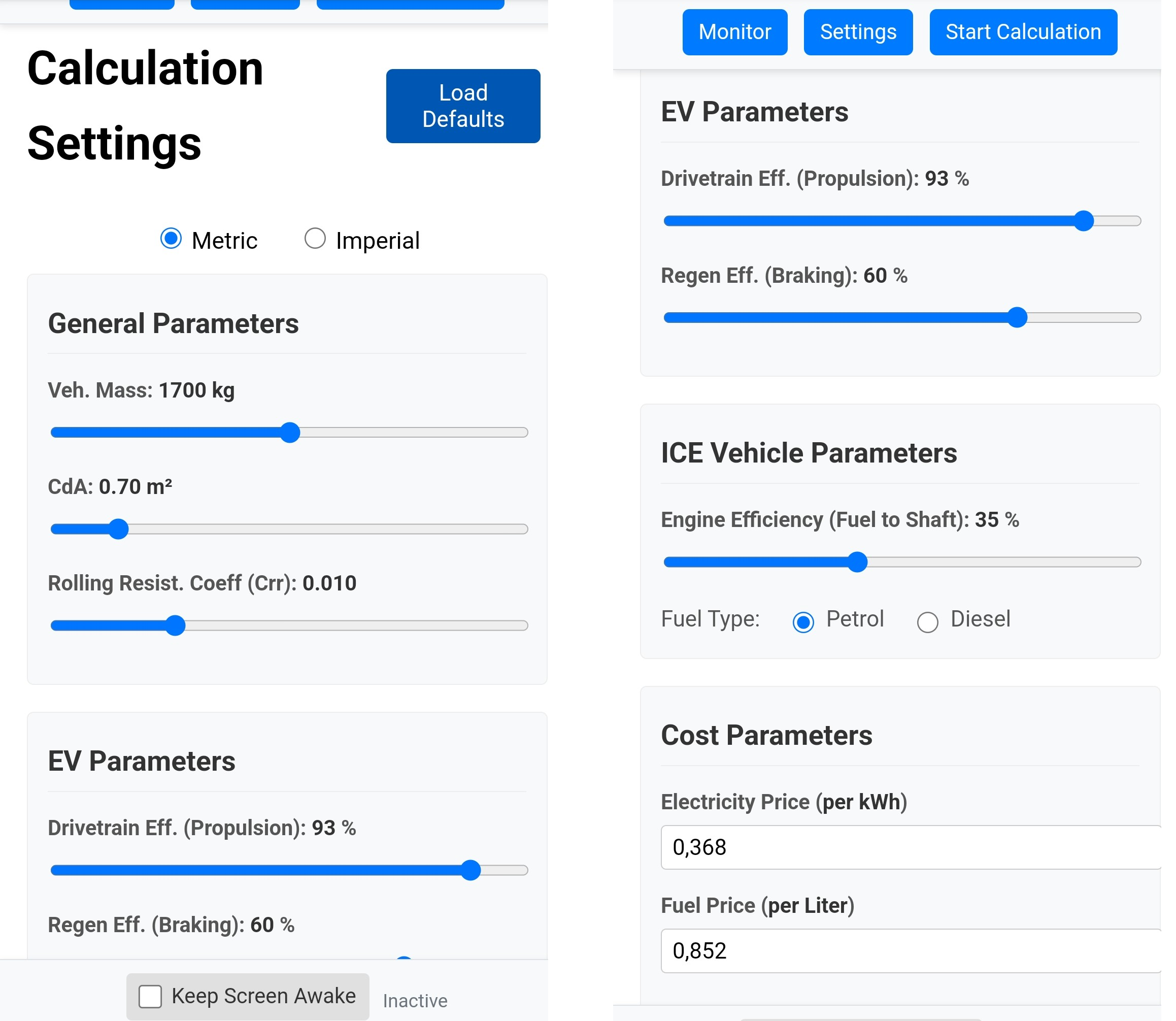
Why Use the Electric Charge vs Fuel Consumption App? Compare & Drive Smarter!
- Understand True Costs: Go beyond dashboard estimates and see the actual energy and financial cost of your journeys.
- Identify Energy Savings: Pinpoint inefficient driving habits, routes, or the impact of speed and acceleration on consumption.
- Compare EV vs. ICE: Use real-world data from *your* driving to compare theoretical costs.
- Optimize Your Driving: Make data-driven decisions to improve your fuel or electric efficiency.
- Start Saving Money: Knowledge is the first step to reducing your vehicle's running costs and lowering your overall energy bill. This tool empowers you to make those savings.
How It Works
The app uses your device's GPS to get real-time location, speed, and altitude data. When you start a calculation, it uses this data along with the parameters you set (like vehicle weight, efficiency, and energy prices) to continuously calculate the forces acting on the vehicle (aerodynamics, rolling resistance, gravity, inertia) and estimate the energy required or regenerated. Costs are then calculated based on the energy/fuel used and your input prices.
Note: Accuracy depends on GPS signal quality. Calculations are physics-based estimates and do not account for all real-world variables (e.g., wind, road surface variations, accessory usage). Location permissions are required.
Calculation Method Details
For those interested in the physics, here's a breakdown of how the energy consumption is estimated between consecutive GPS updates:
1. Input Data
- GPS Data: Speed (m/s), Altitude (m), Timestamp (ms).
- User Settings: Vehicle Mass (kg), CdA (m² - Drag Coefficient x Frontal Area), Crr (Coefficient of Rolling Resistance), Drivetrain Efficiency (%), Regen Efficiency (%), Engine Efficiency (%), Fuel Type (Petrol/Diesel).
2. Calculating Resistive Forces
Between two GPS points, the app calculates the primary forces the vehicle must overcome:
- Aerodynamic Drag (Faero): Calculated as
0.5 * AirDensity * CdA * Speed². This increases significantly with speed. - Rolling Resistance (Froll): Calculated as
Crr * Mass * Gravity. Primarily depends on vehicle weight and tire/road interaction. - Gravitational Force (Fgravity): Calculated based on the change in
altitude (ΔAltitude) between points and the approximate distance traveled (Speed * ΔTime). It's
essentially
Mass * Gravity * (ΔAltitude / Distance), representing the force component due to the slope.
3. Calculating Inertial Force
- Inertial Force (Finertia): Calculated as
Mass * Acceleration, where Acceleration is the change in speed (ΔSpeed) divided by the time interval (ΔTime). This represents the force needed to speed up or slow down the vehicle.
4. Total Force and Power at Wheels
- Total Force (Fwheels): The sum of all the above forces:
Faero + Froll + Fgravity + Finertia. This is the net force required at the wheels. - Power at Wheels (Pwheels): Calculated as
Fwheels * AverageSpeedover the interval. Positive power means propulsion is needed, negative power means the vehicle is decelerating or descending (potential for regeneration).
5. Energy Calculation (Interval)
- Energy at Wheels (Ewheels): Calculated as
Pwheels * ΔTime. This is the energy delivered to or taken from the wheels during the small time interval.
6. Vehicle-Specific Consumption
- EV Consumption/Regen:
- If Ewheels is positive (propulsion), Energy Drawn from Battery =
Ewheels / DrivetrainEfficiency. - If Ewheels is negative (braking/descending), Energy Regenerated to Battery =
abs(Ewheels) * RegenEfficiency(only if deceleration is within a specific range - above a minimum threshold but below a maximum threshold - to simulate realistic regen limits where friction brakes dominate during very hard stops).
- If Ewheels is positive (propulsion), Energy Drawn from Battery =
- Fossil Fuel Consumption:
- If Ewheels is positive, Energy Required from Engine =
Ewheels / DrivetrainEfficiency. - Energy from Fuel Needed =
Energy Required from Engine / EngineEfficiency. - Fuel Consumed (Liters) =
(Energy from Fuel Needed [in kWh]) / FuelEnergyDensity [in kWh/L]. - Fuel is only consumed during propulsion phases.
- If Ewheels is positive, Energy Required from Engine =
These interval calculations are accumulated over the trip to provide the total energy/fuel consumption and cost figures.
